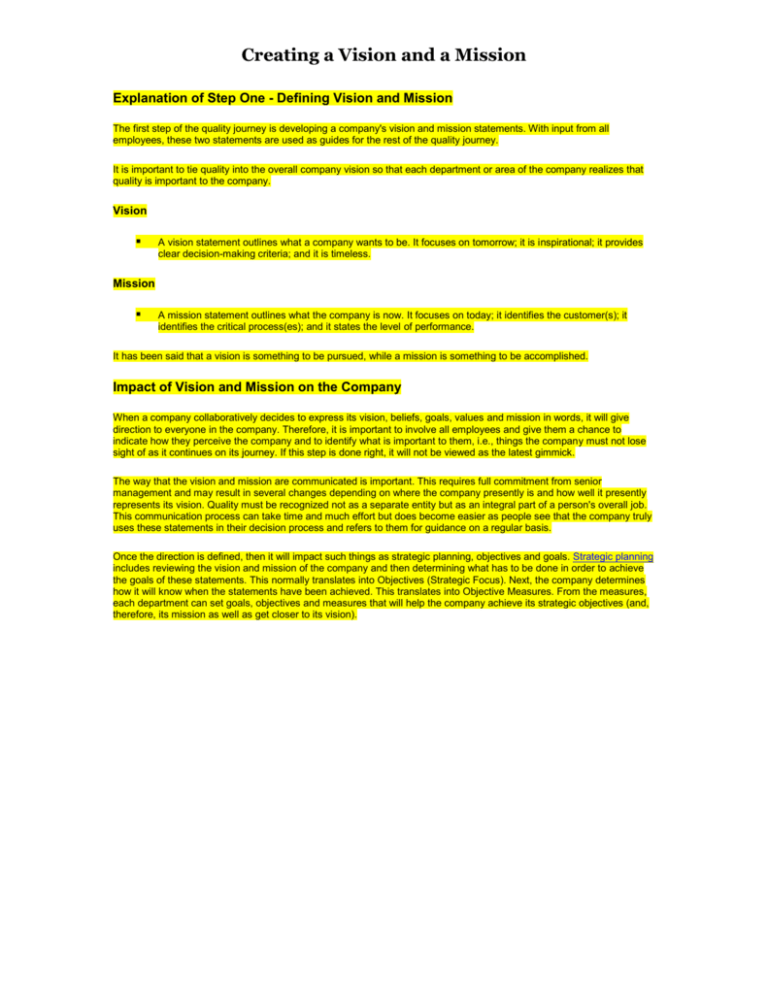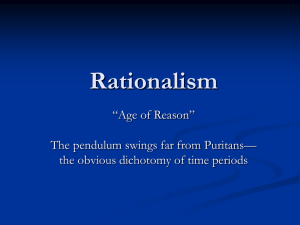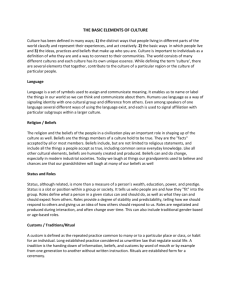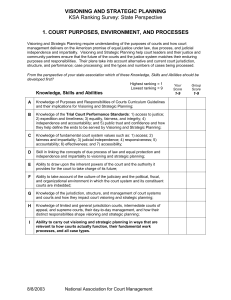Explanation of Step One - Defining Vision and Mission
advertisement

Creating a Vision and a Mission Explanation of Step One - Defining Vision and Mission The first step of the quality journey is developing a company's vision and mission statements. With input from all employees, these two statements are used as guides for the rest of the quality journey. It is important to tie quality into the overall company vision so that each department or area of the company realizes that quality is important to the company. Vision A vision statement outlines what a company wants to be. It focuses on tomorrow; it is inspirational; it provides clear decision-making criteria; and it is timeless. Mission A mission statement outlines what the company is now. It focuses on today; it identifies the customer(s); it identifies the critical process(es); and it states the level of performance. It has been said that a vision is something to be pursued, while a mission is something to be accomplished. Impact of Vision and Mission on the Company When a company collaboratively decides to express its vision, beliefs, goals, values and mission in words, it will give direction to everyone in the company. Therefore, it is important to involve all employees and give them a chance to indicate how they perceive the company and to identify what is important to them, i.e., things the company must not lose sight of as it continues on its journey. If this step is done right, it will not be viewed as the latest gimmick. The way that the vision and mission are communicated is important. This requires full commitment from senior management and may result in several changes depending on where the company presently is and how well it presently represents its vision. Quality must be recognized not as a separate entity but as an integral part of a person's overall job. This communication process can take time and much effort but does become easier as people see that the company truly uses these statements in their decision process and refers to them for guidance on a regular basis. Once the direction is defined, then it will impact such things as strategic planning, objectives and goals. Strategic planning includes reviewing the vision and mission of the company and then determining what has to be done in order to achieve the goals of these statements. This normally translates into Objectives (Strategic Focus). Next, the company determines how it will know when the statements have been achieved. This translates into Objective Measures. From the measures, each department can set goals, objectives and measures that will help the company achieve its strategic objectives (and, therefore, its mission as well as get closer to its vision). Creating a Vision and a Mission What is a Vision? A vision is like a dream. It's where you want to go, what you want to be. It's perfectly acceptable for your vision, your dream to be unattainable, to be just out of reach. It's what you reach for. The vision statement is where you describe this dream to the people who work for you in your business or on your team. For example, for years Pepsi’s vision statement was simply, ‘Beat Coke’. What are Mission Statements? A mission statement describes the primary purpose for your existence – who you serve, what you provide and how you will provide it. When crafting your mission statement, use these questions as a guide: 1. What function does your organization serve? (What needs do you meet?) 2. For whom does your organization perform this function? (Who are your primary clients?) 3. How does your organization go about filling this function? (What activities take place that enable you to meet that need?) 4. What values or beliefs drive you as an organization in your mission? Here’s an example of a mission statement from Lexus U.S.: To attract and retain customers with the highest value products and services and the most satisfying ownership experience in America. Creating a Vision and a Mission When you begin the process of strategic planning, visioning comes first. When visioning the change, ask yourself, "What is our preferred future?" and be sure to: Draw on the beliefs, mission, and environment of the organization. Describe what you want to see in the future. Be specific to each organization. Be positive and inspiring. Do not assume that the system will have the same framework as it does today. Be open to dramatic modifications to current organization, methodology, teaching techniques, facilities, etc. Key Components for Your Vision Incorporate Your Beliefs Your vision must be encompassed by your beliefs. Your beliefs must meet your organizational goals as well as community goals. Your beliefs are a statement of your values. Your beliefs are a public/visible declaration of your expected outcomes. Your beliefs must be precise and practical. Your beliefs will guide the actions of all involved. Your beliefs reflect the knowledge, philosophy, and actions of all. Your beliefs are a key component of strategic planning. Create a Mission Statement Once you have clarified your beliefs, build on them to define your mission statement which is a statement of purpose and function. Your mission statement draws on your belief statements. Your mission statement must be future oriented and portray your organization as it will be, as if it already exists. Your mission statement must focus on one common purpose. Your mission statement must be specific to the organization, not generic. Your mission statement must be a short statement, not more than one or two sentences. Here is an example mission statement: "By providing quality education, we empower individuals to become caring, competent, responsible citizens who value education as a lifelong process." Benefits of Visioning The process and outcomes of visioning may seem vague and superfluous. The long-term benefits are substantial, however. Visioning: Breaks you out of boundary thinking. Provides continuity and avoids the stutter effect of planning fits and starts. Identifies direction and purpose. Alerts stakeholders to needed change. Promotes interest and commitment. Promotes laser-like focus. Encourages openness to unique and creative solutions. Creating a Vision and a Mission Encourages and builds confidence. Builds loyalty through involvement (ownership). Results in efficiency and productivity. Vision Killers As you engage in the visioning process, be alert to the following vision killers: Tradition Fear of ridicule Stereotypes of people, conditions, roles and governing councils Complacency of some stakeholders Fatigued leaders Short-term thinking "Naysayers" Creating a Vision and a Mission Mission statements and vision statements Organizations sometimes summarize goals and objectives into a mission statement and / or a vision statement: A Definition of Vision in a dictionary: 'An Image of the future we seek to create'. A vision statement describes in graphic terms where the goal-setters want to see themselves in the future. It may describe how they see events unfolding over 10 or 20 years if everything goes exactly as hoped. A definition of Mission in a dictionary: purpose, reason for being Many people mistake vision statement for mission statement. They are fundamentally different. Mission statement defines the purpose or broader goal for being in the existence or in the business. It serves as a guide in times of uncertainty, vagueness. It is like guiding light. It has no time frame. The mission can remain the same for decades if crafted correctly. While vision is more specific in terms of objective and time frame of its achievement. Vision is related to some form of achievement if successful. For example, "We help transport goods and people efficiently and cost effectively without damaging environment" is a mission statement. Ford's brief but powerful slogan, "Quality is Job 1" could count as a mission statement. While "We will be one amongst the top three transporters of goods and people in North America by 2010" is a vision statement. It is very concrete and unambiguous goal. To make mission statement effective it needs to be aligned with the prevailing culture in that organization. Mission and Values go hand in hand. A lofty mission statement means nothing if it is not in congruence with the values practiced by the organization. A good example of this is Enron. A mission statement can resemble a vision statement in a few companies, but that can be a grave mistake. It can confuse the people. While a mission statement helps inculcate values in employees, the vision statement has direct bearing on the bottomline and success of the organization. The vision statement can galvanize the people to achieve defined objectives even if they are stretch objectives provided the vision is SMART (Specific, Measurable, Achievable, Realistic and Time Bound). Mahatma Gandhi had a simple vision of getting rid of British rule in India and establish a vibrant democracy in India. He had a specific image of post British India in his mind and he talked of that image at every opportunity and to every one who was willing to listen. Creating a Vision and a Mission The effect of such a powerful vision and articulation of this powerful vision in a simple to understand language was dramatic in the history of India. He and his followers defeated British without using any weapons or any violance. Their mission statement was not to use any violence and to love even the enemy. The 'Satyagraha' was not targeted towards the British people but to unjust, unlawful British imperial rule on India. They could come up with different strategies to achieve their vision while remaining loyal to their mission statement. So the mission and vision both served as a guide. Nelson Mandela used the same tactics in South Africa later. These two examples should be enough to demonstrate the profound impact a powerful vision can have on entire mass of humanity or even on entire generation. Powerful vision statements are very important for any organization to succeed in today's world. Features of an effective vision statement may include: Clarity and lack of ambiguity Paint a vivid and clear picture, not ambiguous Describing a bright future (hope) Memorable and engaging expression Realistic aspirations, achievable Alignment with organizational values and culture, Rational Time bound if it talks of achieving any goal or objective In order to become really effective, an organizational vision statement must (the theory states) become assimilated into the organization's culture. Leaders have the responsibility of communicating the vision regularly, creating narratives that illustrate the vision, acting as role-models by embodying the vision, creating short-term objectives compatible with the vision, and encouraging others to craft their own personal vision compatible with the organization's overall vision.






